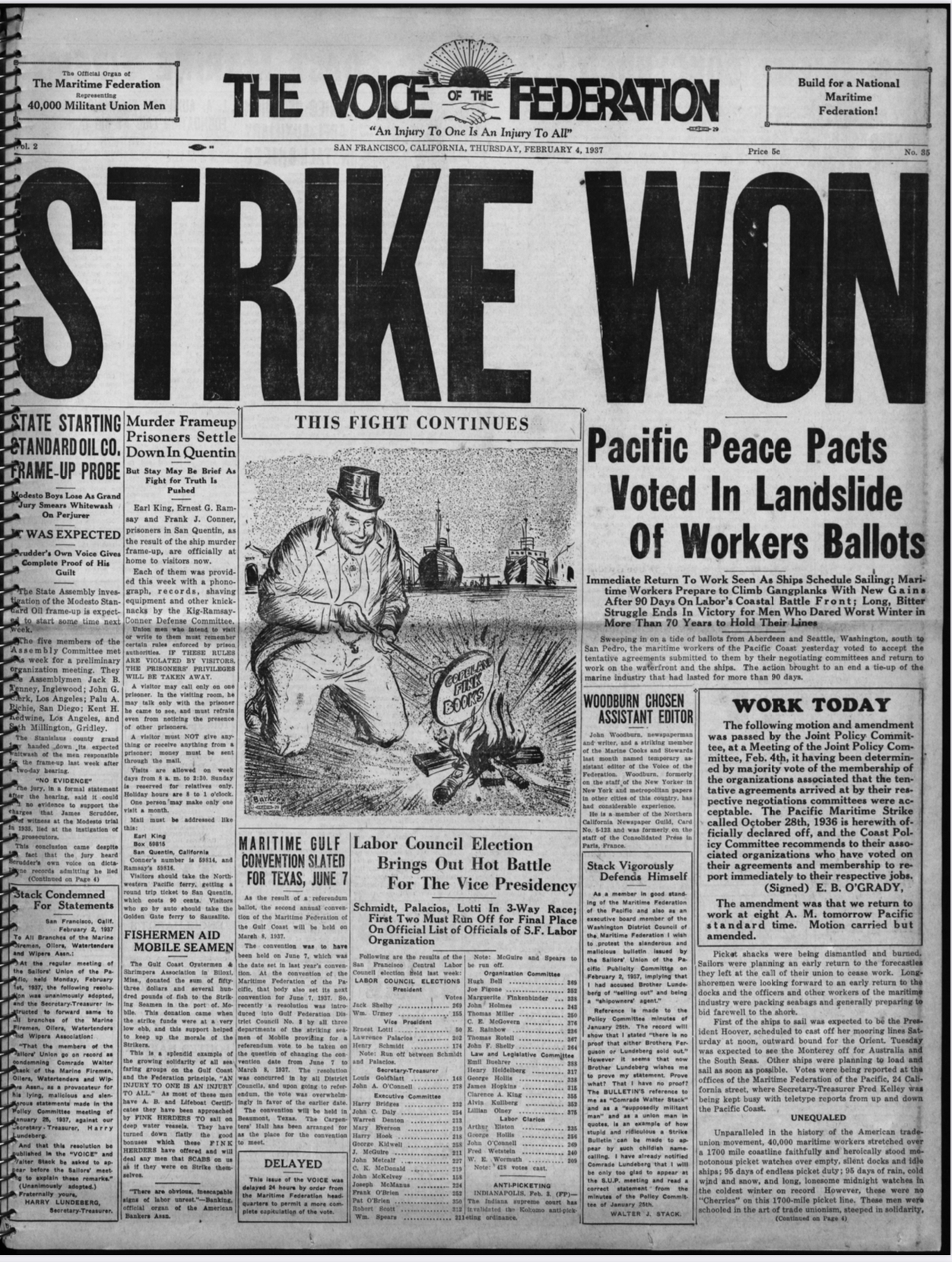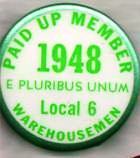These in-depth historical essays explore fascinating issues and incidents. Each is fully illustrated with photos and newspaper articles. Graduate and undergraduate students in History and Labor Studies at the University of Washington produced these articles.
Longshore workers |
|
 |
"Labor's Great War on the Seattle Waterfront: A History of the 1934 Longshore Strike," by Rod Palmquist
This four-part essay details the dramatic history of the 1934 waterfront strike in the Pacific Northwest, concentrating on events in Seattle.
|
 |
The Seattle Press and the 1934 Waterfront Strike, by Rachelle Byarlay The 1934 longshore strike up and down the West Coast was one of the most explosive and successful strikes during the Depression. An analysis of three Seattle newspapers here shows the shifts in news coverage for and against the strike. |
 |
News Coverage of the 1934 Strike Here are more than 600 fully readable newspaper articles about the strike that appeared in Seattle newspapers between May and August 1934 |
 |
The 1936 Pacific Maritime Workers Strike The 1936 Pacific Coast Maritime Workers’ Strike was a pivotal moment in American labor history. After a 99-day struggle, maritime unions walked away from the strike with a number of gains, but the most important result was the creation of the ILWU. |
 |
The 1948 Waterfront Strike : Solidifying the ILWU The 1948 strike was a surprising victory for the ILWU. Defying the Taft-Harley Act and the red-baiting strategy of employers, the union secured its future. This award winning essay is the most complete account of the strike. |
 |
The 1971 ILWU Strike : 130 Days to Victory The story of the longest strike ever conducted by the ILWU |
 |
News Coverage of the 1971 Longshore Strike |
 |
The Pacific Coast Longshoremen, by Kristen Ebeling The Longshoremen began one year after the 1934 longshore strike, as the official newspaper of the International Longshoremen's Association. |
 |
Black Longshoreman: The Frank Jenkins Story, by Megan Elston Frank Jenkins was one of the first non-white members of the ILWU, and advocated for increased civil rights within the labor movement. |
Cannery Workers |
|
 |
The Murders of Virgil Duyungan and Aurelio Simon and the Filipino Cannery Workers' Union, by Nicole Dade
In 1936, two leaders of the Filipino Cannery Workers' and Farm Labor Union were shot to death, weakening the union but also providing the fragmented Filipino community with a cause to unite behind. |
 |
Cannery Worker's and Farm Laborer's Union 1933-1939: Their Strength in Unity, by Crystal Fresco Organized in 1933, the union represented "Alaskeros," the men who shipped out each spring to work in the Salmon canneries of Alaska. This essay narrates the dramatic early years of CWFLU which much later became Local 37 of the ILWU. |
 |
"The Local 7/Local 37 Story: Filipino-American Cannery Unionism in Seattle 1940-1959" by Micah Ellison This essay explores the critical middle period as the union negotiated the 1940s and 1950s, dealing with deportation threats, internal turmoil, but also consolidating and becoming a critical resource for Filipino-American communities on the West Coast. |
 |
Victorio Velasco, Pioneer Filipino American Journalist, by Erik Luthy Velasco was the central figure in Filipino American journalism in the Northwest. This paper traces his political evolution toward progressive politics. |
 |
Philippine-American Chronicle, by Rache Stotts-Johnson The Chronicle was the paper of the Filipino-led cannery workers' union, as well as a source of progressive news for the Filipino and labor communities in Seattle. |
Maritime Workers |
|
 |
Maritime Workers and Their Unions By Michael Reagan Sailors and other seafaring workers built some of the earlier and most unions on the West Coast. Here are historic photos and short articles about the Sailors Union of the Pacific, Marine Cooks and Stewards, and Marine Engineers Benevolent Association. |
 |
Desegregating a Maritime Union: the Marine Cooks and Stewards. Details the struggle to desegregate a union that by the late 1940s promoted gay rights as well as civil rights. |
 |
Jerry Tyler and Labor Radio: An Activist Life Maritime worker, labor activist, and radio personality, Jerry Tyler was the radio voice of organized labor in Seattle and the Pacific Northwest. He is most remembered as the host of Reports from Labor, a popular radio show in the Seattle area which ran from 1948 to 1950. |
 |
Seattle's CIO Radio: Reports from Labor Reports from Labor was a fifteen-minute, biweekly labor radio show that aired in Seattle between July 1948 and October 1950, making it a rare pro-labor voice during difficult times for working people and progressive politics. This essay details the history of the program and includes complete audio recordings of key shows. |
 |
Revels Cayton: African American Communist and Labor Activist, by Sarah Falconer
A leader of the Marine Cooks and Stewards union, Revels Cayton was the most prominent African American communist, labor leader, and activist in the Northwest during the 1930s and 1940s. |
Fishing Workers |
|
 |
The International Fishermen and Allied Workers of America: Organizing Precarious Workers in the CIO Era This award winning five-part essay details the history of the CIO union that organized fishermen and cannery workers from Alaska to San Diego. By the late 1940s IFAWA represented over a third of the West Coast workforce. It was the largest and most successful fisherman’s union in American history. |
Shipyard Workers |
|
 |
The Ship Scalers Union and Seattle’s Racial Progressivism in the 20th Century The Ship Scalers Union helped pioneer civil rights unionism in the Northwest. By the end of World War II half the members were African Americans and the union had become a force for progressive racial politicals and leftwing activism. |
 |
Seattle's Shipyards on the Eve of the 1919 General Strike A strike by 30,000 shipyard workers set up the General Strike of 1919. This essay examines labor issues in the shipyards in the year before the strike. It includes a database of 142 digitized newspaper articles about shipyard workers from Seattle newspapers in 1918. |